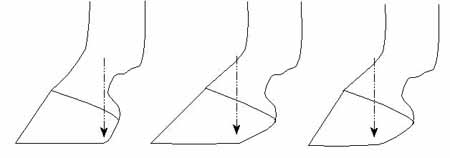 What You Can Do About
Asymmetry Some people include massage, electro-magnetic therapy, chiropractic, or other forms of bodywork in their efforts to correct asymmetry in their horse. This can be extremely beneficial but if the cause of your horse’s asymmetry is not being addressed, then these treatments cannot fully resolve the issues, and the problem is likely to recur. It is therefore essential to ascertain the reason for your horse’s asymmetry. If it can be traced to a known or suspected injury, then appropriate rehab treatment may take care of the problem. If the cause is more obscure, it may be necessary to consider not just saddlefit, but also rider influence, dental health and/or hoof balance, either with or without the rehab work. I would then recommend re-educating the horse’s nervous system to enhance the horse’s ability to remain comfortable (see the article entitled “Making Sense of Movement.”) It’s also extremely important to ensure that the horse’s hooves are correctly balanced so that their effect on the horse’s symmetry is as beneficial as possible. Hooves should be balanced side-to-side. Front feet should ideally match each other, as should the hinds, and should appear more symmetrical than not. Underrun heels are highly undesirable, as are heels that are too high and feet that are contracted ad/or too long (this is covered in another article), and these conditions can drastically affect the way a horse moves. These are just a few of the areas to watch. Even slightly unbalanced feet can put pressure on the horse’s shoulders and/or back, possibly causing asymmetry due to discomfort and restricting the freedom of the shoulder.
Dental problems can also cause asymmetry. Of course wild horses manage just fine without dentists, but domestic breeding programs can produce horses that wouldn’t have survived in the wild, and then we force an unnatural life on them and provide feedstuffs they would never encounter in the wild, all of which can and do affect tooth wear. It is now recognized by many experts that it isn’t enough to just smooth off the edges on our horses’ teeth, and dental specialists should be consulted to alleviate and prevent dental problems. However, the most common cause of asymmetry in the horse is leaning — placing more weight on one shoulder than the other as a result of handedness. This can be partially addressed during ground-handling and riding, during which the horse is taught to carry himself in better balance, but it helps to have an understanding of which parts of the horse’s body is not carrying its fair share of the load, and how to help equalize that load. Identifying asymmetry and understanding how it affects your horse is just the first step in helping him maximize his performance and stay sounder longer. Previous | Riding Theory Main Page | Asymmetry | Asymmetry
and Perfor mance | Email : rafalet2ride@yahoo.ca | Home | Lusitanos | Equine
Biomechanics & Riding Theory
| Last updated July 29, 2001 All rights reserved |
|
